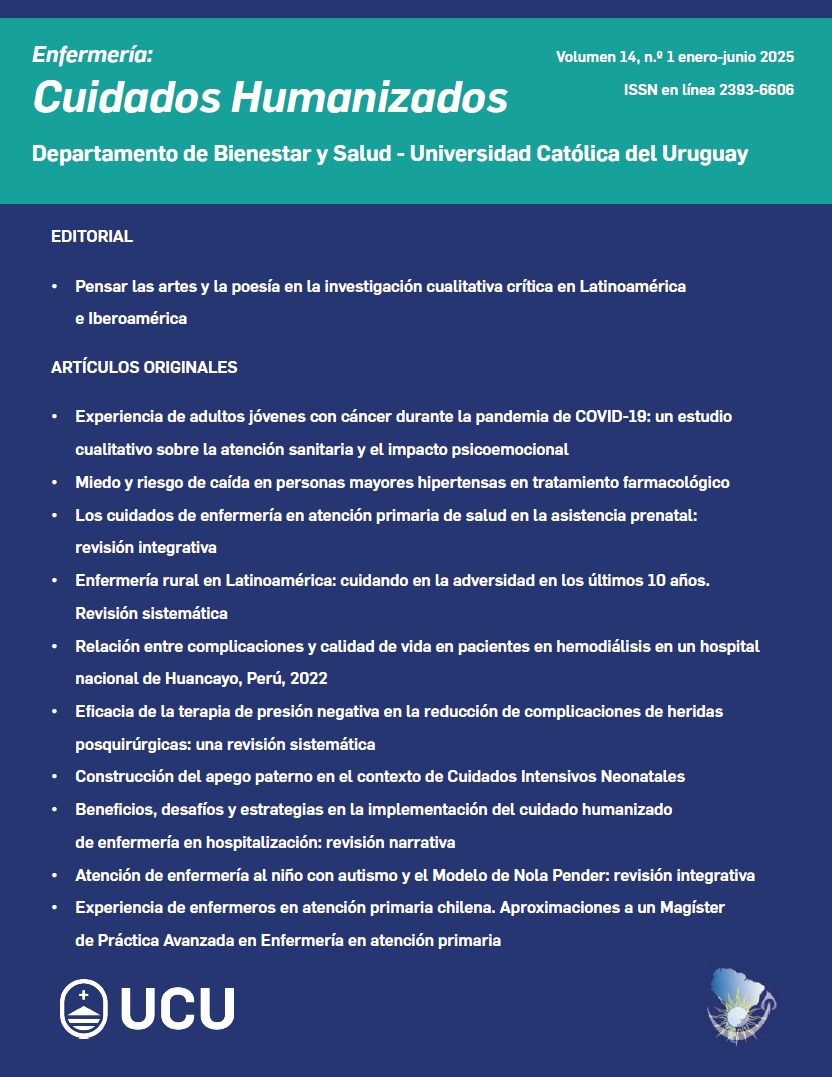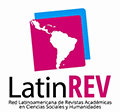Effectiveness of Negative Pressure Wound Therapy in Reducing Postoperative Complications: A Systematic Review
DOI:
https://doi.org/10.22235/ech.v14i1.4428Keywords:
negative pressure wound therapy, postoperative complications, wound healing, surgical wound, surgical wound infectionAbstract
Introduction: Postoperative wound complications, such as infections, seromas, and dehiscence, represent a global health challenge. Negative Pressure Wound Therapy (NPWT) is an advanced technique that accelerates wound healing through the application of controlled subatmospheric pressure, reducing the risk of infection and promoting tissue regeneration. Objective: To analyze the effectiveness of NPWT in reducing postoperative complications and improving clinical outcomes in various surgical contexts. Methodology: A systematized review was conducted following the PRISMA guidelines. The following databases were consulted: PubMed, Scopus, Web of Science, SciELO, LILACS, Redalyc, Dialnet, ScienceDirect, Medigraphic and Ciberindex. DeCS and MeSH descriptors were used, including: “negative pressure wound therapy,” “wound healing,” “surgical wound infection,” and “postoperative complications,” along with their Spanish equivalents, combined using Boolean operators AND and OR. Studies published between 2017 and 2024 in English, Spanish, and Portuguese were included. Results: The reviewed studies demonstrated that NPWT significantly reduces the incidence of infections (by approximately 35 % compared to conventional methods) and dehiscence (by 30-40 %). Key success factors include wound location, type of surgery, and individual patient characteristics such as obesity, diabetes, and advanced age. Conclusions: The evidence suggests that NPWT is an effective intervention for reducing postoperative complications —particularly infections and dehiscence— in patients with complex wounds and comorbidities. The studies report consistent improvements in healing time and clinical outcomes, especially in high-risk surgical procedures.
Downloads
References
Organización Mundial de la Salud. La OMS recomienda 29 formas de detener las infecciones quirúrgicas y evitar microorganismos multirresistentes [Internet]. OMS; 2025 [citado 2024 jun 17]. Disponible en: https://www.who.int/es/news/item/03-11-2016-who-recommends-29-ways-to-stop-surgical-infections-and-avoid-superbugs
José-Borjas E, Bejarano S, Martinez-Miranda P, Toledo J, Campos G, Fajardo V, et al. Presencia de infección de sitio quirúrgico en procedimientos gineco-obstétricos en un hospital de II nivel de atención, Honduras 2017-2018. Rev. chil. obstet. ginecol. [Internet]. 2021 [citado 2024 jun 16];86(1):42-51. doi: 10.4067/S0717-75262021000100042
Hinojosa Guerrero JE, Mendez Zuñiga CR, Ostaiza Véliz IV, Ureta Centeno WL. Ventajas del uso de la terapia de presión negativa en heridas quirúrgicas. S. E. [Internet]. 2022 [citado 2024 jun 17];E(Esp.1). doi: 10.37954/se.v0i0.92
Cajas Bejarano CJ. Factores asociados a la complicación de heridas postquirúrgicas. Cirugía General, Hospital General IESS, Milagro. 2018. RECIAMUC [Internet]. 2019 [citado 2024 sep 19];3(1):464-482. doi: 10.26820/reciamuc/3.(1).enero.2019.464-482
Ocaña Jiménez J, Abadía Barno P, Ramos Rubio D, Pina Hernández JD, García Pérez JC, Moreno Montes I, et al. Papel de la terapia presión negativa en la prevención de infección del sitio quirúrgico en cirugía colorrectal. Cir Esp [Internet]. 2019;97(5):268-274. doi: 10.1016/j.ciresp.2019.03.001
Bueno-Lledó J, Martínez-Hoed J, Pous-Serrano S. Terapia de presión negativa en cirugía de la pared abdominal. Cir Esp [Internet]. 2022 [citado 2024 jun 17];100(8):464–71. doi: 10.1016/j.ciresp.2021.12.006
Cerezo-Millán P, López-Casanova P, Verdú-Soriano J, Berenguer-Pérez M. Conocimientos del personal sanitario respecto al uso de la terapia de presión negativa en el tratamiento de las heridas. Gerokomos [Internet]. 2018 [citado 2024 sep 19];29(4):181-191. Disponible en: https://scielo.isciii.es/scielo.php?script=sci_arttext&pid=S1134-928X2018000400181
Pardal-Refoyo JL, Pardal-Peláez B. Anotaciones para estructurar una revisión sistemática. Rev ORL [Internet]. 2020 [citado 2024 oct 11];11(2):155-160. doi: 10.14201/orl.22882
Hernández Lalinde JD, Bermúdez V, Arias V, Chacín M, Pahuana M, Barroso M. Indicadores de rendimiento de citas: clasificación e importancia. Arch Venez Farmacol Ter. 2018 [citado 2024 oct 11];37(3):172-175. Disponible en: https://www.redalyc.org/journal/559/55963208001/html/
Norman G, Shi C, Goh EL, Murphy EMA, Reid A, Chiverton L, et al. Negative pressure wound therapy for surgical wounds healing by primary closure. Cochrane Libr [Internet]. 2022; 4(4):CD009261. doi: 10.1002/14651858.cd009261.pub7
Santana-Romero C, Santiago-González N, Martínez-López Y, Antonio-Francisco N, Tortolero-Sánchez CR, González-Olivares DB, et al. Sistema de presión negativa como tratamiento de la ventana torácica: informe de un caso. Rev Enferm Neurol [Internet]. 2023;22(1):93-99. doi: 10.51422/ren.v22i1.416
Quilindo Giraldo CI, Ramirez Román JA, Martinez JP. Terapia de presión negativa como tratamiento alternativo en el manejo de una úlcera vascular arterial de miembros inferiores. Rev médica Risaralda [Internet]. 2020;26(1). doi: 10.22517/25395203.21271
de Castro Oliveira M, Andrade AYT de, Turrini RNT, Poveda V de B. Negative pressure wound therapy in the treatment of surgical site infection in cardiac surgery. Rev Bras Enferm [Internet]. 2020;73(5). doi: 10.1590/0034-7167-2019-0331
García-Montero A, Viedma-Contreras S, Martínez-Blanco N, Gombau-Baldrich Y, Guinot-Bachero J. Abordaje multidisciplinar de una dehiscencia abdominal infectada: evaluación coste-consecuente de apósitos y medidas utilizadas. Gerokomos [Internet]. 2018 [citado 2024 nov 8];29(3):148-152. Disponible en: https://scielo.isciii.es/scielo.php?script=sci_arttext&pid=S1134-928X2018000300148&lang=es
Andrade-Alegre R, Díaz A, Juárez H. Terapia de presión negativa para pacientes con enfisema subcutáneo y neumomediastino masivo. Revista Colombiana de Cirugía [Internet]. 2022;37(2):305-307. doi: 10.30944/20117582.932
Pontillo-Walerovsky M, Ferreira-Pozzi M, Wagner-Taustanowski G, Trostchansky-Vasconcellos I. Presión negativa como tratamiento de la exposición de la malla luego de una eventroplastia. Cir. parag. [Internet]. 2022 [citado 2024 nov 8];46(1):32-35. doi: 10.18004/sopaci.2022.abril.32
Cervera-Simón M, Vila-Abad E. Comparativa entre cura en ambiente húmedo y terapia de presión negativa en lesiones por presión. Revisión bibliográfica. Gerokomos [Internet]. 2022 [citado 2024 nov 6];33(4):263-268. Disponible en: https://scielo.isciii.es/scielo.php?script=sci_arttext&pid=S1134-928X2022000400011&lang=es
Ibáñez Rodríguez B, Maestre Bernat L, Moya Martínez D, Bodro Marimont M, Hernández Carceny C. ¿Es posible la terapia de presión negativa en hospitalización a domicilio?: caso clínico. Gerokomos [Internet]. 2021 [citado 2024 nov 9];32(2):136-139. Disponible en: https://scielo.isciii.es/scielo.php?script=sci_arttext&pid=S1134-928X2021000200136&lang=es
García-Corral JR, Cárdenas-Lailson LE, Sanjuan-Martínez CA, Arellano-Solorio CH, Aquino-Matus JE, Carrillo-Romero A. Terapia de presión negativa combinada con tracción fascial mediante malla en el tratamiento de la necrosis pancreática infectada. Una nueva opción terapéutica. Cir Cir [Internet]. 2019 [citado 2024 nov 6];87(2):219-223. doi: 10.24875/ciru.18000472
Fuentes CF, Córdoba Guzmán AC, Daza Castro EM, Aponte D, González C, Sabbagh LC. Terapia E-VAC como tratamiento de complicaciones en cirugía gastrointestinal en centro de referencia de gastroenterología en Colombia: Serie de casos. Rev Gastroenterol Peru [Internet]. 2023 [citado 2024 nov 8];43(2):e1472. doi: 10.47892/rgp.2023.432.1472
Sánchez ES. Abordaje herida compleja de difícil cicatrización mediante Terapia de Presión Negativa. Paraninfo Digital [Internet]. 2020 [citado 2024 nov 6];(31):e3133. Disponible en: https://ciberindex.com/index.php/pd/article/view/2787
Monroy-Hernández D, López-Ugalde AC. Terapia de heridas con presión negativa en fascitis necrosante descendente de retrofaringe como sustituto al tratamiento quirúrgico convencional. An Orl Mex. [Internet]. 2023 [citado 2024 nov 6];68(3):100-106. doi: 10.24245/aorl.v68i3.8677
Bermúdez A, Daroca T, García N, Martín M de LÁ, Vignau JM, Carmona C, et al. Impacto de la terapia de vacío en el tratamiento de las infecciones profundas y mediastinitis tras esternotomía media en los últimos 10 años. Cir Cardiovasc [Internet]. 2017;24(5):293-297. doi: 10.1016/j.circv.2016.11.054
González MF, Malagón HHO, Gerez ÁKP, et al. Uso de sistemas de cierre asistido al vacío (VAC) en heridas quirúrgicas infectadas en región cervicofacial (presentación de un caso clínico y revisión de la literatura). Rev Mex Cir Bucal Maxilofac. [Internet]. 2017 [citado 2024 nov 8];13(2):40-50. Disponible en: https://www.medigraphic.com/cgi-bin/new/resumen.cgi?IDARTICULO=75582
Llamas Fernández S. Actualización de los resultados de la Terapia de Presión Negativa: Revisión Sistemática. Nure Inv. [Internet]. 2023 [citado 2024 oct 11];20(112). doi: 10.58722/nure.v20i122.2340
Downloads
Published
How to Cite
Issue
Section
License
Copyright (c) 2025 Enfermería: Cuidados Humanizados

This work is licensed under a Creative Commons Attribution 4.0 International License.

















